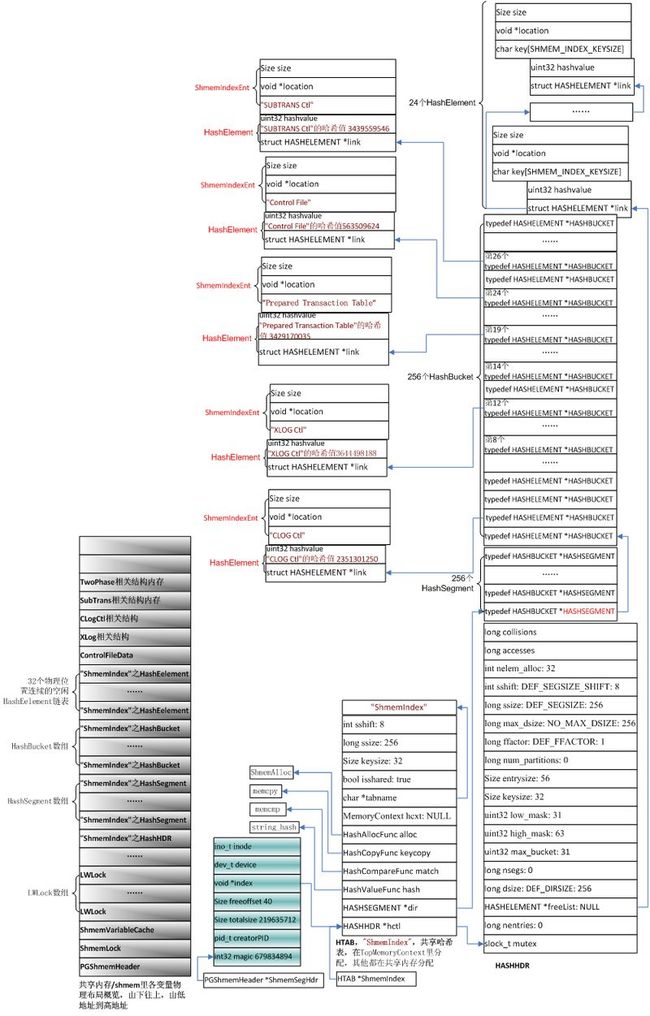PostgreSQL启动过程中的那些事七:初始化共享内存和信号六:shmem中初始化twophase
pg 初始化 shmem ,给其加上索引 "ShmemIndex" 后,接着就在 shmem 里初始化 xlog 。然后依次初始化 clog 、 subtrans 、 twophase 、 multixact 。安排按 clog 、 subtrans 、 multixact 、 twophase 的顺序写,把 twophase 放到 multixact 之后是因为前面三个用了相同的算法和数据结构,连起来写可以加深印象和归类记忆。这一篇讨论 twophase 的初始化。
分布式事务在 pg 里用两阶段提交( twophase )支持,发起者给一个全局事务 ID ( GID )标识该事务,同时涉及到的数据库有一个本地事务, pg 里是 prepare 事务。
每一个全局事务(global transaction ,简写为gxact )都和一个全局事务ID (GID )相关。每个客户端用PREPARE TRANSACTION 命令分配一个GID 给一个postgres 事务,做两阶段提交准备。
pg 在共享内存数组里保持所有活跃全局事务。当PREPARE TRANSACTION 命令发起后,这个全局事务的GID 被保存在数组里。这些发生在WAL 日志记录之前,因为如果已经有一个相同GID 的已处于prepared 状态全局事务时,可以检查重复GID 和退出事务。
一个全局事务(gxact) 还有一个辅助的PGPROC 放在ProcArray 数组里。这方便了PGPROC 勾住这个全局事务(gxact )的锁。
为了从崩溃/ 关闭后再启动时一切正常,所有准备好的事务必须存储在永久存储中。这包括锁信息,等待的通知(pending notifications )等。所有状态信息写入到data/pg_towphase 文件夹里的每事务状态文件。
1 先上个图,看一下函数调用过程梗概,中间略过部分细节
初始化 twophase 方法调用流程图
2 初始化 xlog 相关结构
话说 main()-> … ->PostmasterMain()-> … ->reset_shared() -> CreateSharedMemoryAndSemaphores()> … -> TwoPhaseShmemInit () ,初始化支持分布式事务的两阶段提交 / TwoPhase 相关数据结构 TwoPhaseState 等,用作内存里管理和缓存两阶段提交 / TwoPhase (对应于存放在 "data/ pg_twophase" 文件夹里的文件)。
TwoPhaseShmemInit ()->ShmemInitStruct() , 在其中 调用 hash_search() 在哈希表索引 "ShmemIndex" 中查找 " Prepared Transaction Table " ,如果没有,就在 shmemIndex 中给 " Prepared Transaction Table " 分一个 HashElement 和 ShmemIndexEnt ( entry ) ,在其中的 Entry 中写上 " Prepared Transaction Table " 。返回 ShmemInitStruct() ,再调用 ShmemAlloc() 在共享内存上给 " Prepared Transaction Table " 相关结构(见下面“ TwoPhase 相关结构图” )分配空间,设置 entry (在这儿即ShmemIndexEnt 类型变量)的成员 location 指向该空间, size 成员记录该空间大小 , 最后返回 ShmemInitStruct() ,让 TwoPhaseStateData * 类型静态 全局变量 TwoPhaseState 指向 TwoPhaseStateData 结构 , TwoPhaseStateData 的起始地址就是在shmem 里给 " Prepared Transaction Table " 相关结构分配的内存起始地址,设置其中 TwoPhaseStateData 结构类型的成员值。
相关变量、结构定义和 初始化完成后数据结构图在下面。
typedef struct TwoPhaseStateData
{
/* Head of linked list of free GlobalTransactionData structs */
GlobalTransaction freeGXacts;
/* Number of valid prepXacts entries. */
int numPrepXacts;
/*
* There are max_prepared_xacts items in this array, but C wants a
* fixed-size array.
*/
GlobalTransaction prepXacts[1]; /* VARIABLE LENGTH ARRAY */
} TwoPhaseStateData; /* VARIABLE LENGTH STRUCT */
static TwoPhaseStateData *TwoPhaseState;
/*
* GlobalTransactionData is defined in twophase.c; other places have no
* business knowing the internal definition.
*/
typedef struct GlobalTransactionData *GlobalTransaction;
typedef struct GlobalTransactionData
{
PGPROC proc; /* dummy proc */
TimestampTz prepared_at; /* time of preparation */
XLogRecPtr prepare_lsn; /* XLOG offset of prepare record */
Oid owner; /* ID of user that executed the xact */
TransactionId locking_xid; /* top-level XID of backend working on xact */
bool valid; /* TRUE if fully prepared */
char gid[GIDSIZE]; /* The GID assigned to the prepared xact */
} GlobalTransactionData;
struct PGPROC
{
/* proc->links MUST BE FIRST IN STRUCT (see ProcSleep,ProcWakeup,etc) */
SHM_QUEUE links; /* list link if process is in a list */
PGSemaphoreData sem; /* ONE semaphore to sleep on */
int waitStatus; /* STATUS_WAITING, STATUS_OK or STATUS_ERROR */
LocalTransactionId lxid; /* local id of top-level transaction currently
* being executed by this proc, if running;
* else InvalidLocalTransactionId */
TransactionId xid; /* id of top-level transaction currently being
* executed by this proc, if running and XID
* is assigned; else InvalidTransactionId */
TransactionId xmin; /* minimal running XID as it was when we were
* starting our xact, excluding LAZY VACUUM:
* vacuum must not remove tuples deleted by
* xid >= xmin ! */
int pid; /* Backend's process ID; 0 if prepared xact */
/* These fields are zero while a backend is still starting up: */
BackendId backendId; /* This backend's backend ID (if assigned) */
Oid databaseId; /* OID of database this backend is using */
Oid roleId; /* OID of role using this backend */
bool inCommit; /* true if within commit critical section */
uint8 vacuumFlags; /* vacuum-related flags, see above */
/*
* While in hot standby mode, shows that a conflict signal has been sent
* for the current transaction. Set/cleared while holding ProcArrayLock,
* though not required. Accessed without lock, if needed.
*/
bool recoveryConflictPending;
/* Info about LWLock the process is currently waiting for, if any. */
bool lwWaiting; /* true if waiting for an LW lock */
bool lwExclusive; /* true if waiting for exclusive access */
struct PGPROC *lwWaitLink; /* next waiter for same LW lock */
/* Info about lock the process is currently waiting for, if any. */
/* waitLock and waitProcLock are NULL if not currently waiting. */
LOCK *waitLock; /* Lock object we're sleeping on ... */
PROCLOCK *waitProcLock; /* Per-holder info for awaited lock */
LOCKMODE waitLockMode; /* type of lock we're waiting for */
LOCKMASK heldLocks; /* bitmask for lock types already held on this
* lock object by this backend */
Latch procLatch; /* generic latch for process */
/*
* Info to allow us to wait for synchronous replication, if needed.
* waitLSN is InvalidXLogRecPtr if not waiting; set only by user backend.
* syncRepState must not be touched except by owning process or WALSender.
* syncRepLinks used only while holding SyncRepLock.
*/
XLogRecPtr waitLSN; /* waiting for this LSN or higher */
int syncRepState; /* wait state for sync rep */
SHM_QUEUE syncRepLinks; /* list link if process is in syncrep queue */
/*
* All PROCLOCK objects for locks held or awaited by this backend are
* linked into one of these lists, according to the partition number of
* their lock.
*/
SHM_QUEUE myProcLocks[NUM_LOCK_PARTITIONS];
struct XidCache subxids; /* cache for subtransaction XIDs */
};
/* shmqueue.c */
typedef struct SHM_QUEUE
{
struct SHM_QUEUE *prev;
struct SHM_QUEUE *next;
} SHM_QUEUE;
关于上面的PGPROC 结构这里再说一下。
每一个后台进程(backend )在共享内存里有一个PGPROC 结构。还有一个当前未使用的PGPROC 结构列表可以从中给新的backend 分配。
Links :任何PGPROC 在列表里。当等待锁时,PGPROC 被链接到锁的等待进程队列里(lock's waitProcs queue )。一个回收的PGPROC 被链接到ProcGlobal 的freeProcs 列表里。
pg 的两阶段提交事务管理器还为每一个当前prepared 事务创建一个假PGPROC 结构。这些PGPROC 结构出现在ProcArray 数据结构以至于/ 目的是prepared 事务显示/ 看起来仍然在运行且正确的显示其持有锁。通过它的pid 等于0 这个事实,一个prepared 事务PGPROC 能够和一个真正的进程在需要的时候能够被区别 。在一个prepared 事务PGPROC 里的信号和lock-activity 字段是不用的,但它的myProcLocks[] 数组列表是有效的。
下面看看初始化完 " Prepared Transaction Table " 相关结构后在内存中的结构图
初始化完 twophase 相关结构 的内存结构图
为了精简上图,把创建 shmem 的哈希表索引 "ShmemIndex" 时创建的 HCTL 结构删掉了,这个结构的作用是记录创建可扩展哈希表的相关信息。增加了左边灰色底的部分,描述 共享内存 /shmem 里各变量物理布局概览,由下往上,由低地址到高地址。其中的 "twophase" 相关结构 图在下面给出,要不上面的图太大太复杂了。
twophase 相关结构图


